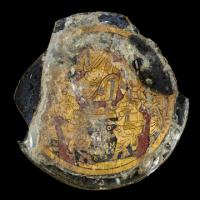About the research project

A fine gold-glass base of a serving dish showing Christ enthroned between Peter and Paul and below them the named saints Timothy, Sixtus, Simon and Florus. c. AD 380-400
The Ashmolean Museum holds around 300 Latin inscriptions, originating from Britain and from further afield across the Roman world. The collection is highly diverse and includes a wide range of different types of inscriptions. Many are monumental inscriptions such as epitaphs, commemorations and religious dedications, but more still can be found upon everyday objects including pewterware, pottery and even a set of panpipes. None of these inscriptions on its own is of any especial historical significance but together they offer insights into the Roman world, its commemorative habits, social hierarchy, economic networks and uses of literacy. This project, Latin Inscriptions, aims to open up this line of communication with the ancient world by translating and making the inscriptions publicly accessible through an online resource.
Research aims
Through the publication of the inscriptions online, this project aims to open up the potential for further study and engagement with these important resources. It will show how Latin inscriptions can illuminate the society, economy and religion of the past, and will explore the ways in which Latin continued to be used in Britain even after the end of the Roman era. The online resource will provide a springboard for other activities, allowing this material to be integrated into future projects and public programmes and exploring how digital resources can be embedded into different contexts for the benefit of professional scholars, students, teachers, schoolchildren and museum visitors alike.
Project team led by
Dr Alison Cooley, University of Warwick
Dr Susan Walker, Ashmolean Museum, University of Oxford
Dr Charles Crowther, University of Oxford